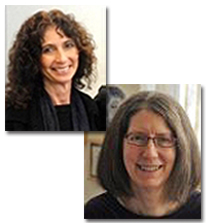Idie Benjamin and Dale Sides Cooperman
 What is a mitzvah? It is a word we use with children all the time. We describe different behaviors as “doing a mitzvah.” But what is a mitzvah? Why do we do them? Why should we do them? And what should we be teaching children about them, and why should we be encouraging them to do them?
What is a mitzvah? It is a word we use with children all the time. We describe different behaviors as “doing a mitzvah.” But what is a mitzvah? Why do we do them? Why should we do them? And what should we be teaching children about them, and why should we be encouraging them to do them?
Although often translated as “good deed,” the root of the word “mitzvah” means “to command. “ The mitzvot are historical and traditional obligations that Jews had with God and with one another. They formed the core of Jewish practice and defined Judaism. But at first glance, many of these are not a “good deed.”
Consider the many Jewish behaviors we teach young children – all of them mitzvot:
- lighting Shabbat candles
- saying a brakhah before we eat
- giving tzedakah
- eating in a sukkah
- caring for the earth
- visiting the sick
- feeding the hungry
- honoring parents
- observing Shabbat
- studying Torah
- observing kashrut
- being careful in our speech
- returning lost objects
- eating matzah on Pesah
As this list illustrates, there are two kinds of mitzvot. There are mitzvot bein adam lamakom (commandments between a person and God) that connect us to God and mitzvot bein adam lehavero (commandments between a person and his friend) that show us how to behave towards one another.
When we only tell children (and ourselves) that a mitzvah is a “good deed,” we are not giving children the depth, or the full meaning of the word. This does not allow them to connect with the depth and richness of Judaism and gain understanding about what Jews “do.” We are teaching them a truncated version of Judaism that does not allow them to fully be a part of and learn from our tradition.
This is not about whether or not we are “observant,” nor is it about how we view God and the issue of being commanded. It is about how we educate our children and give them a growing awareness of the range and beauty of the Jewish behaviors that shape Judaism.
What is so very interesting is that in our programs children have the opportunity to do both kinds of mitzvot. We eat in sukkot, we say prayers and blessings, Fridays are all about Shabbat, holidays are a major focus, and the stories of the Torah are our stories. The question is whether we are describing what we are doing as a mitzvah. Are we being mindful about how we framing the multitude of other things that Jews do, the things that define us as Jews?
What does mitzvah mean to you? That could depend on the vision and orientation of your setting. For some, it is a commandment. A commandment might be defined as something God as told us to do. It might also be defined as an obligation that helps connect us with other Jews and to God. Mitzvot are behaviors that Jews do. They make us Jewish. In the Torah, we read about what God wants us to do. In the Torah, we read about what God has commanded us to do. These are all ways to describe a mitzvah. It is not where the Torah came from that is important. What is important is that it is here and as real to us as it was to our ancestors. For our children, the Torah and the mitzvot can be their source of security as it teaches, guides, and supports them.
Rabbi Gunther Plaut defines a mitzvah as a “religious opportunity.” Each time we perform a mitzvah, we are connecting ourselves to something greater, more important. We have an opportunity to be more spiritual, more connected to God, and more connected to the world around us, to make it a better place and us better people. All religious traditions (and secular humanists) prescribe “good deeds.” If we define mitzvot only as good deeds, what then makes Judaism different from other traditions? What is unique about us? What makes our holiness different from that of others? It is the entire “mitzvah system” that then defines who we are. All behaviors are opportunities. The mitzvot frame those behaviors Jewishly.
Rabbi Gordon Tucker has described mitzvah as “our language, that which gives our lives as Jews meaning….” Our children need to hear the word mitzvah used in its complete sense as a way to learn “our language.” At some point in their lives we hope they will examine what they believe about where the Torah comes from and the idea of being commanded. They must choose their adult Jewish path. But to be able to examine their beliefs, they must have a full knowledge and understanding of Judaism.
If we begin their Jewish education with mitzvah only as a good deed, we are not doing our children any favors. If we use mitzvah language correctly, we are creating the opportunity to help our children in developmentally appropriate ways to learn about all the mitzvot they can do and to understand the reasons behind them. Let us use Jewish language to frame the appropriate limits and boundaries we set to structure their lives and give them security. Let us give them all kinds of Jewish opportunities. Remember – learning Torah is a mitzvah.
A version of this article first appeared in the JECA Journal: First Years – HaGil HaRach, Volume I, Issue 1, September 2010/Tishrei 5771 of the Jewish Early Childhood Association of Greater New York.

